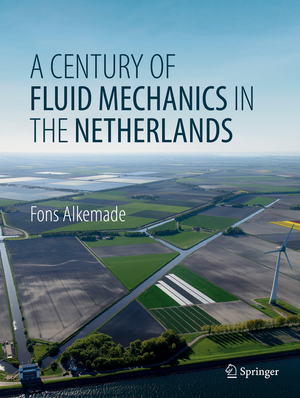A Century of Fluid Mechanics in The Netherlands
Autor Fons Alkemadeen Limba Engleză Hardback – 27 mai 2019
Preț: 261.49 lei
Nou
Puncte Express: 392
Preț estimativ în valută:
50.04€ • 51.95$ • 41.73£
50.04€ • 51.95$ • 41.73£
Carte disponibilă
Livrare economică 04-18 martie
Preluare comenzi: 021 569.72.76
Specificații
ISBN-13: 9783030035853
ISBN-10: 3030035859
Pagini: 146
Ilustrații: VII, 155 p.
Dimensiuni: 210 x 279 x 16 mm
Greutate: 0.59 kg
Ediția:1st ed. 2019
Editura: Springer International Publishing
Colecția Springer
Locul publicării:Cham, Switzerland
ISBN-10: 3030035859
Pagini: 146
Ilustrații: VII, 155 p.
Dimensiuni: 210 x 279 x 16 mm
Greutate: 0.59 kg
Ediția:1st ed. 2019
Editura: Springer International Publishing
Colecția Springer
Locul publicării:Cham, Switzerland
Cuprins
Chapter 1 Introductory Remarks.- Chapter 2 Coping with Air and Water in The Netherlands before 1918.- Chapter 3 The Making of A ‘New’ Branch in Science and Engineering.- Chapter 4 Developments after 1955.- Chapter 5 Research in Fluid Mechanics: Flows.- Chapter 6 Research in Fluid Mechanics: Approaches.- Chapter 7 Capita Selecta.- Chapter 8 Epilogue (Glossary, Sources, About the Author)
Textul de pe ultima copertă
In October 1918, Jan Burgers, 23 years old, started as professor of ‘aerodynamics, hydrodynamics, and their applications’ at the Technical University in Delft. This can be regarded as the birth of fluid mechanics in the Netherlands, not only as an academic discipline but also as the start of the serious study of flow phenomena in engineering environments. During the period of Burgers’ tenure in Delft (till 1955) three Dutch institutes were founded which to this day remain important centres of research in various fields of fluid mechanics: aerospace engineering, hydraulics, and naval engineering. Burgers and others developed mathematical, experimental, and numerical approaches of a broad range of fluid flows; some of their achievements have become well-known worldwide and can be seen as highlights of Dutch fluid mechanics. From the 1950s ‘stromingsleer’ (flow theory) attained a permanent and respected place in the curriculum and research of (technical) universities, at many old and new research institutes and also at several industrial research laboratories. In the 1980s fluid mechanics finally became ‘recognized’ as a serious branch of physics and an important field of (applied) science. This resulted in a close cooperation between academic groups, institutes and industry and the foundation of the Burgerscentrum, the Research School for Fluid Mechanics in the Netherlands.
One hundred years after Burgers’ appointment in Delft, Dutch fluid mechanics is still very much alive. This volume gives a full account of its rich history and also offers a view on the broad range of areas of application: transport, energy production, biology and medicine, production processes, etc. It has been written not only for those working in this field but also for those interested in the history of Dutch science and in the development of science and the fascinating world of fluid flow phenomena.
Caracteristici
The first survey of fluid mechanics in The Netherlands during the past century A richly illustrated, comprehensive overview of fluid mechanics in all its aspects Suitable for professionals as well as the general public
